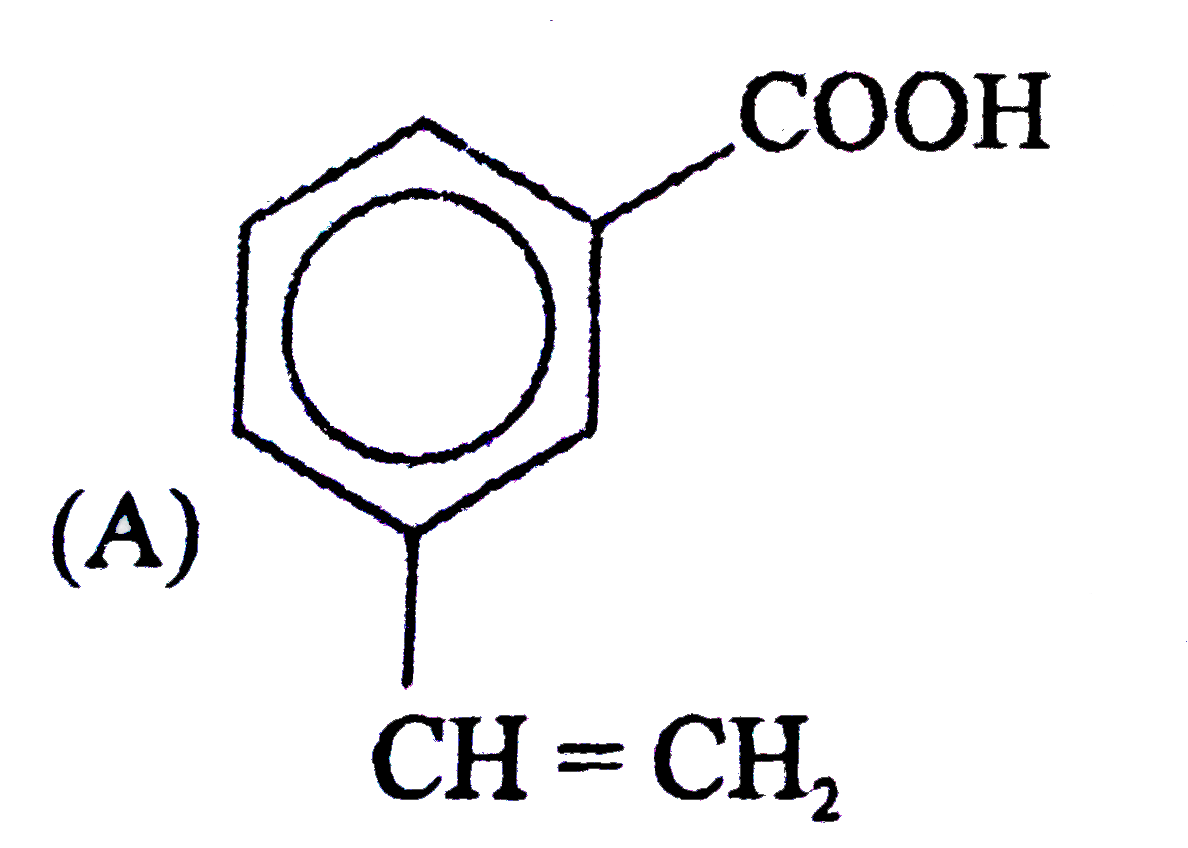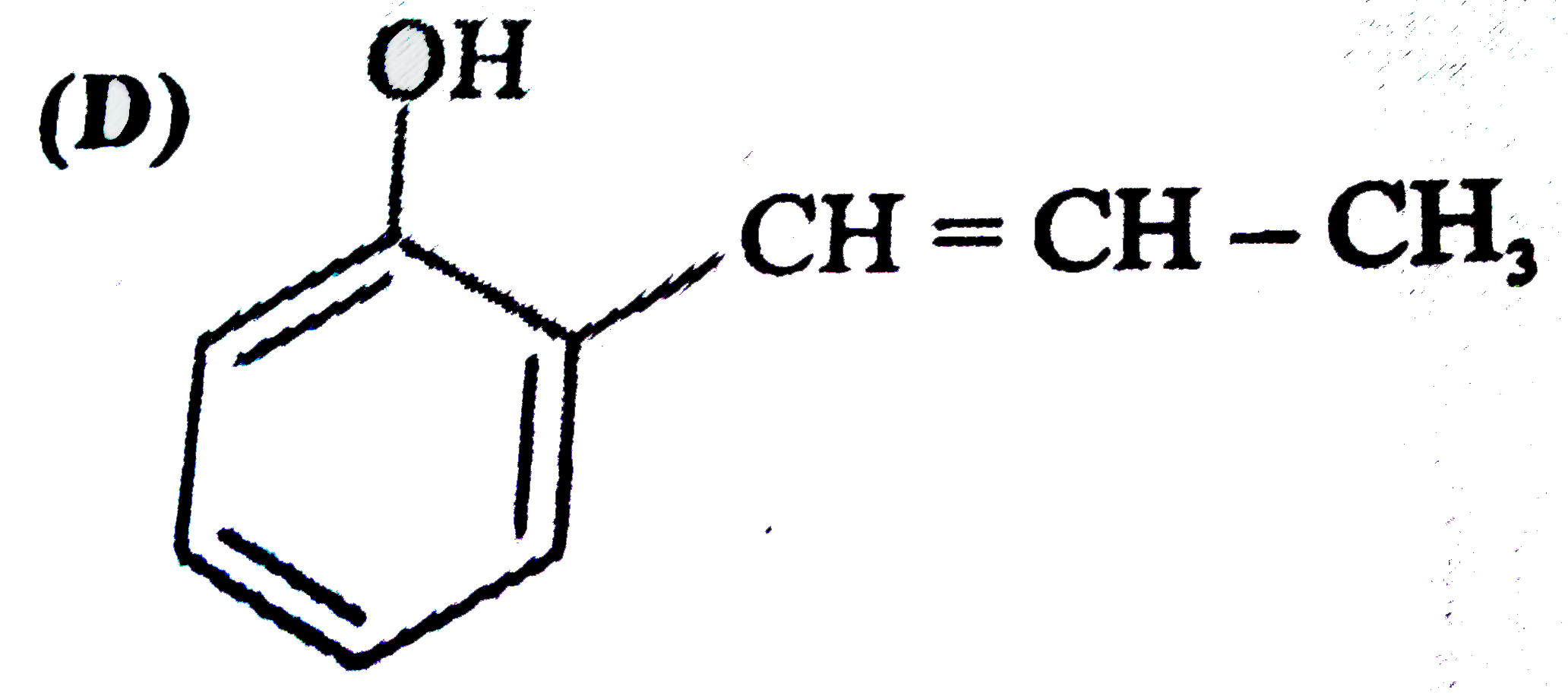Compound (A), C10H12O gives off hydrogen on treatment with sodium metal and decolourises Br2 in CCl4 to give (B), C10H12OBr. (A) on treatment with I2 in NaOH gives iodoform and an acid (C) after acidification. Give the structure of (A) to (C) and also of all geometrical and optical isomers of (A).
Answer the following based on the above.
Which of the following statements regarding A are incorrect ?
In the presence of acidic medium Aforms a 5 membred ring.
A has 2 geometrical isomers.
A has 4 pairs of diasteereomers
A has 2 chiral centres
The correct Answer is:D
Topper's Solved these Questions
- ALCOHOLS, ETHERS, PHENOLBOOK - NARAYNACHAPTER - ALCOHOLS, ETHERS, PHENOLEXERCISE - Matrix Matching Type Questions
5 Videos
- ALCOHOLS, ETHERS, PHENOLBOOK - NARAYNACHAPTER - ALCOHOLS, ETHERS, PHENOLEXERCISE - Integer Type Questions
20 Videos
- ALCOHOLS, ETHERS, PHENOLBOOK - NARAYNACHAPTER - ALCOHOLS, ETHERS, PHENOLEXERCISE - Multiple Correct Answer Type Questions
19 Videos
- 18TH GROUP ELEMENTSBOOK - NARAYNACHAPTER - 18TH GROUP ELEMENTSEXERCISE - LEVEL - VI
34 Videos
- ALDEHYDES, KETONES & CARBOXYLIC ACIDSBOOK - NARAYNACHAPTER - ALDEHYDES, KETONES & CARBOXYLIC ACIDSEXERCISE - CHECK YOUR GRASP
6 Videos
Similar Questions
Compound 'P' (C10H12O) evolves H2 gas with Na metal.It reacts with Br2/CCl4 to give 'Q' (C10H12Br2O).With I2/NaOH it forms iodoform and an acid 'R' (C9H8O2) .'P' has geometrical and optical isomers. The struture of 'P' and 'R' should be
View SolutionCompound A(C4H8) on treatment with gives compound B which is optically inactive. What is structure of A?
View Solution
Knowledge Check
Compound (A), C10H12O gives off hydrogen on treatment with sodium metal and decolourises Br2 in CCl4 to give (B), C10H12OBr. (A) on treatment with I2 in NaOH gives iodoform and an acid (C) after acidification. Give the structure of (A) to (C) and also of all geometrical and optical isomers of (A).
Answer the following based on the above.
Compound B isA B
B C
C D
D
Compound (A), C10H12O gives off hydrogen on treatment with sodium metal and decolourises Br2 in CCl4 to give (B), C10H12OBr. (A) on treatment with I2 in NaOH gives iodoform and an acid (C) after acidification. Give the structure of (A) to (C) and also of all geometrical and optical isomers of (A).
Answer the following based on the above.
Compound A isA B
B C
C D
D
Compound 'P'(C10H12O) evolves H2 gas with Na metal. It reaches with Br2/CCl4 to give 'Q'(C10H12Br2O). With I2NaOH it forms iodoform andan acid 'R'(C9H8O2). 'P' has geometrical and optical isomers. The sturcture of 'P' and 'R' should be
A BPH−CH=CH−COOHC
BPH−CH=CH−COOHC D
D
(A) C2H12O (ether) on treatment with PCl5 forms alkyl chlorides (B) and (C ) . (B) and (C ) both on treatment with aq. NaOH give alcohol (D) and (E ), both (D) and (E ) give iodoform test. What are (A),(B),(C ), (D) and (E ) ?
View SolutionCompound 'P' (C10H12O) evolves H2 gas with Na metal.It reacts with Br2/CCl4 to give 'Q' (C10H12Br2O).With I2/NaOH it forms iodoform and an acid 'R' (C9H8O2) .'P' has geometrical and optical isomers. The struture of 'P' and 'R' should be
View SolutionAn organic compound A (C9H10O) does not evolve any gas on reatement with Na-metal but on hydrolysis with dil. H2SO4 gives B(C9H12O2) which on further treatement with alkaline solution of iodine gives an yellow precipitate. Also A on treatment with excess of conc. HBr gives C(C9(H11OBr) as the major product. C on further treatment with C2H5ONa/C2H5OH followed by acidification of product gives D (an isomer of A). D on ozonolysis followed by work-up with dimethyl sulphide gives ortho hydroxyl benzaldehyde as one of the product. Answer the following three questions based on the above information.
Which of the following statement regarding B is correct?
View SolutionAn aromatic compound T(C10H10O2) give 2 moles of CHI3 and compound U(C8H4O4Na2) on treatment with I2 and NaOH. After acidification U gives two mononitro products on nitration. [GOC-POC]
Compound (T) can also be obtained by ozonolysis of V, in this ozonolysis one mole of OHC−CHO is obtained alongwith (T).
Which of the following statement is true [GOC-POC]
View SolutionAn organic compound A (C9H10O) does not evolve any gas on reatement with Na-metal but on hydrolysis with dil. H2SO4 gives B(C9H12O2) which on further treatement with alkaline solution of iodine gives an yellow precipitate. Also A on treatment with excess of conc. HBr gives C(C9(H11OBr) as the major product. C on further treatment with C2H5ONa/C2H5OH followed by acidification of product gives D (an isomer of A). D on ozonolysis followed by work-up with dimethyl sulphide gives ortho hydroxyl benzaldehyde as one of the product. Answer the following three questions based on the above information.
The statement that is true regarding A to D is
View Solution
